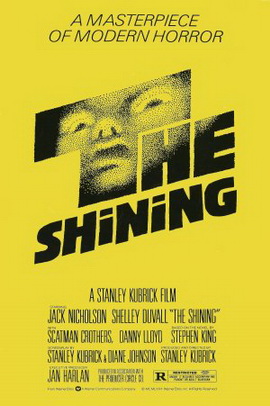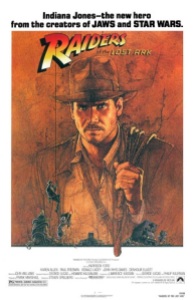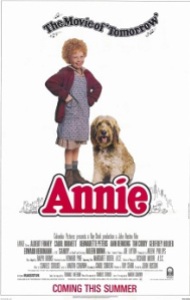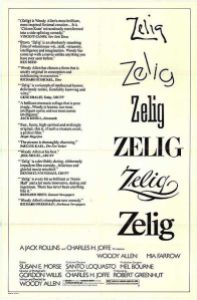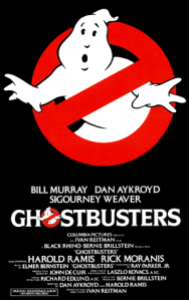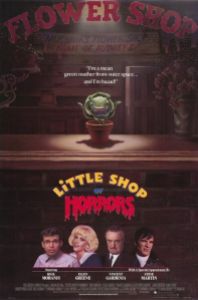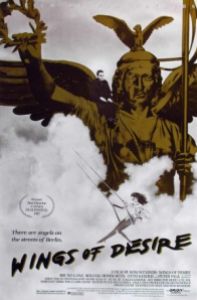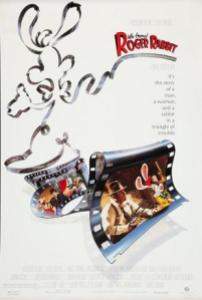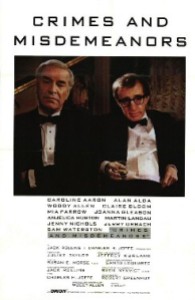The Shining (1980)
Writer Jack Torrance takes a job as a winter caretaker at the Overlook Hotel which was built on a Native American burial ground. Haunted by the numerous evil spirits which populate the hotel, Jack slowly loses his mind and unsuccessfully attempts to kill his wife, Wendy and young son, Danny.
Contrary to what Mr. King expressed in the afterword to his sequel, Doctor Sleep, this is far superior to the original novel.
Many of the scenes from this harrowing descent into madness have become iconic, but none more than this:
Much has been written about the dense symbolism and imagery of Stanley Kubrik’s masterpiece, and there’s even a documentary dedicated to the numerous conspiracy theories surrounding the film.
Raiders of the Lost Ark (1981)
In 1936, archeologist Indiana Jones is summoned to help find the Ark of the Covenant before it falls into the hands of the Nazis.
Buried beneath pulpy adrenaline, the film does have something to say about faith and the supernatural, but interpreting an Indiana Jones film is like riding a roller coaster and focusing on the physics.
This movie is rolling boulders, melting faces, and pits of vipers, not metaphysical pontification.
Few actors create one iconic character in their careers; Harrison Ford did it twice in four years. Sadly, he never achieved the same heights again, but this is partially the result of unfair and unjustified expectations after his initial, unprecedented success.
George Lucas has become a popular object of derision, but Star Wars and Indiana Jones should be more than enough to secure his legacy and we should forgive him for the indulgent Howard the Duck (1986) and the less than stellar prequel films.
Annie (1982)
John Huston was nominated for a Razzie for Worst Director and Aileen Quinn won the Razzie for Worst Supporting Actress (odd since she was the titular character and in nearly every scene). In spite of the critical consensus, I unashamedly love this film and invariably smile when I think of it.
How could a movie directed by John Huston and starring Carol Burnett, Tim Curry, Bernadette Peters, and Albert Finney not be awesome?
I admit my adoration is informed by childhood nostalgia. Judge me if you want, but this schmaltzy film is infectiously optimistic, and contains sone of my favorite musical numbers.
Zelig (1983)
Leonard Zelig (Woody Allen) possesses a chameleon-like ability to assume the characteristics of the people around him. When he’s in Harlem, he’s a black man; when he’s in Mexico, he’s a Mexican; when he’s in a jazz club, he’s a jazz musician. During a hospitalization to cure his condition, he falls in love with his nurse (Mia Farrow).
The movie is styled like a documentary; contemporary intellectuals such as Susan Sontag and Saul Bellow offer their analysis of Zelig’s life while we view “archival” footage of him with the rich and powerful of the 1920s, including Charles Lindbergh, Babe Ruth, Carole Lombard, and Adolf Hitler.
Amazingly, eleven years before Robert Zemeckis wowed audiences with Forrest Gump, Allen and cinematographer Gordon Willis covered a lot of the same ground without the benefit of sophisticated computer technology.
In this existential comedy, the story of Leonard Zelig becomes an allegory for the nature of identity: do we define ourselves or are we defined by others?
Ghostbusters (1984)
Peter Venkman (Bill Murray), Raymond Stantz (Dan Aykroyd), and Egon Spengler (Harold Ramis) are struggling parapsychologists at Columbia University. When they develop a technique for trapping ghosts and supernatural beings, they become mini-celebrities, until the nefarious EPA shuts them down. But when the evil Gozer the Gozerian threatens the existence of NYC, the ragtag, unorthodox Ghostbusters are the last best hope for the city.
This film created a genre (sci-fi comedy), propelled Bill Murray to superstardom, warned us against crossing streams, and gave us the fantastic theme song by Ray Parker, Jr.
Few films in the past thirty years have had a bigger impact on poplar culture; every science fiction film since exists in the significant shadow of the Stay Puft Marshmallow Man.
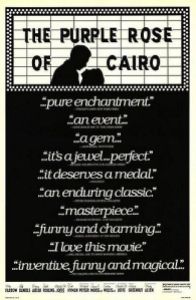
The Purple Rose of Cairo (1985)
During the Great Depression, Cecilia (Mia Farrow) goes to the movies to escape her bleak existence. When she’s watching The Purple Rose of Cairo for the umpteenth time, one of the primary characters, Tom Baxter (Jeff Daniels). miraculously walks out of the screen and joins her in the theater.
Tom and Cecilia fall in love, but this is complicated when Gil Shepherd, the actor playing Tom in the movie, arrives to convince him to return to the fantasy world of the film.
Drawing inspiration from Buster Keaton’s Sherlock, Jr. (1924) among others, this film asks if reality or fantasy is more important.
Movies about movies are one of my favorite motifs; movies about the Golden Age of Cinema even more so.
During his fertile collaboration with lover Mia Farrow, Woody Allen could do little wrong; this is no exception.
Little Shop of Horrors (1986)
Seymour Krelborn (Rick Moranis) and Audrey are coworkers at Mushnik’s Flower Shop. The shop is struggling until Seymour showcases an unusual plant he bought from a rival Chinese florist. The only problem: this plant, which Seymour names “Audrey II,” is actually an alien which needs human blood to survive.
The movie features Steve Martin as a cruel dentist, Miriam Margoyles as his nurse, Bill Murray as his masochistic patient, and John Candy as a radio DJ.
Directed by Frank Oz, this surreal, dark comedy is an adaptation of an off-Broadway musical inspired by a 1960 film. What sets it apart is the astounding energy in every scene. Like a bizarre children’s version of Rocky Horror Picture Show (1975), this is as chaotic as Airplane! (1980), and as surreal as a Dali painting, with a catchy rock soundtrack.
It’s a tad too cynical (in the original ending, Audrey II destroys the world), but the relentless gallows humor is so infectious and irrepressible, it’s impossible not to love.
Wings of Desire (1987)
Two angels, Damiel and Cassiel, roam Berlin, watching the humans in the city and listening to their inner thoughts.
Damiel falls in love with a trapeze artist, Marion and, growing bored with infinity, renounces his immortality to be with her.
It was remade for American audiences as the more conventional City of Angels (1998), but this film is about more than the sacrifices of love. Wim Wenders creates a black and white rumination on the nature of existence with Peter Falk giving a career defining performance as a fictionalized version of himself.
Who Framed Roger Rabbit (1988)
When Marvin Acme is murdered, cartoon superstar Roger Rabbit is the primary suspect and private investigator Eddie Valiant (Bob Hoskins) reluctantly agrees to help prove Roger’s innocence. Eventually, Valiant discovers Judge Doom (Christopher Lloyd) framed Roger and is secretly working to destroy Toontown and replace it with a freeway.
Robert Zemeckis (who also directed Back to the Future and Forrest Gump) has a clear talent for visually inventive films, and while technological advancements make this movie seem a little dated, it still works because its premise is every kid’s fantasy: cartoon characters are real.
As a kid, Judge Doom was my hated nemesis in one of the toughest video games I ever played. Beating him is on my video game bucket list.
If you like classic animation and have ever dreamed of seeing your beloved characters on screen together, this is a must see.
Crimes and Misdemeanors (1989)
Successful ophthalmologist Judah Rosenthal (Martin Landau) is having an affair with Dolores Paley (Anjelica Huston). When she threatens to expose their affair, he arranges for someone to kill her.
Cliff Stern (Woody Allen) is hired by his brother-in-law Lester (Alan Alda) to make a documentary. During the job, he falls in love with Lester’s assistant, Halley (Mia Farrow). The finished product is a satire of Lester’s life and work and, to Cliff’s dismay, Halley announces her engagement to Lester.
Nearing the end of the second phase of Woody Allen’s career (coinciding with his relationship with Mia Farrow), this movie is a wonderfully tragi-comic interpretation of Doystoyevsky, which asks important questions about the nature of guilt and the relationship between art and commerce.
